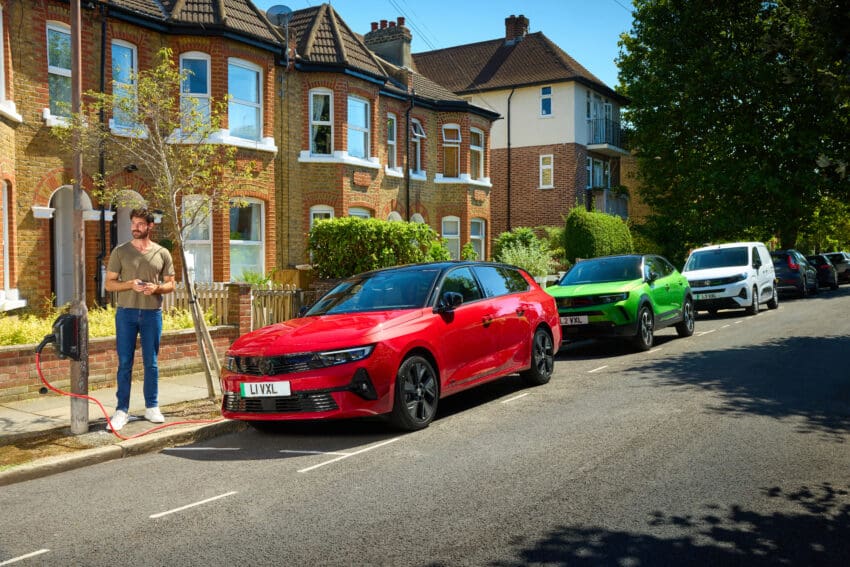
Drivers just need a little nudge to make the EV switch, says Vauxhall boss
We speak to Vauxhall managing director James Taylor about the brand’s all-electric strategy, the ZEV mandate and why encouraging drivers to switch to electric is about more than just making EVs more affordable
EV Powered: Vauxhall has committed to being an EV-only brand by 2028 but we’ve heard quite a few other manufacturers softening their stance on that. Is that still the target for Vauxhall?
James Taylor: Yes. Today we’re at the launch of Grandland and we launched Frontera the other week as well. So every single vehicle in the range is electrified. Clearly we’ve got the government ZEV mandate as well, and the Labour government has said it will bring the ICE ban back to 2030, which will then dictate compliance by that point anyway.
But I think the really important part for us now is choice. And what we have got now in the entire range is that choice for the customer to say, ‘I can have a traditional ICE car or mild hybrid, or I can have an electric vehicle’. And over time, then we’ve got to see how our demand grows. For electric vehicles, we want a decarbonised future, so we fully hope that we can stick to that timeframe.
EVP: So in terms of that growth, how is Vauxhall looking in terms of BEV mix now and projecting into the next couple of years?
JT: We are pretty much there at this point. We’ve set our stall out to be compliant with the ZEV mandate this year at 22%. And that’s partly business reasons and partly because as a brand we want to be part of making sure that we decarbonise the UK automotive arena. So it’s very important to us that, where the government sets that target, we achieve it.
We’ve had a very good quarter three. Dealer network sales are approaching 30% BEV mix in September, and we’re just under 20% at this point now with a quarter of the year to go, so we’re very much set to make sure that we do meet that target this year.
And then with the launch of Grandland and new Frontera at the start of next year, obviously we’ll be able to attack next year with two new products in addition to the ones we’ve had this year. So that’s a step up to 28 percent that we feel well placed to deliver.

I think beyond that, when you get to 33% and then a couple of years after that you’re at 50%, what is clear – and we’ve called on this a number of times – is we’d also like to see the government come in to support.
We’re doing our bit in terms of providing a great range of products, but I think what we do need is some additional incentives for the private retail motorist to consider buying an electric car. So we’d call on a redistribution of some of the benefits of company car taxation, and to use some of that money for the private motorist.
Also for those without off-street parking, again, we’ve called on the government to introduce 5% VAT on public charging, the same as on your domestic tariff. Because we do need, if we’re going to achieve those targets in the out years, government to put some stimulus in for demand as well.
EVP: The most recent SMMT figures show a slight growth in BEV sales, but not massive, and the SMMT and several manufacturers wrote to the Chancellor, requesting action to help boost sales. So do you think that the ZEV mandate is the right thing at the right time? Does it need to be softened or do we need those incentives to get to that 80% by 2030?
JT: The government sets the parameters by which we all have to work by, and what we want is consistency. Under the previous government, the ICE ban got put back from 2030 to 2035. The Labour government have said they will bring that ban back to 2030. So that will then give us some clarity and we’re back to the rules that we were working to a year or so ago. I think to get to those levels, particularly in the medium term, I think we do need government action on some stimulus for the private retail motorists.
The other part is infrastructure, and we’d call on government to speed up the access to the grid. But also look at mandated targets for the on-street charging in residential areas. Similar to where councils and the Labour government have talked about housing targets. What we are calling for is some infrastructure targets that have to be met to make sure that those people without off-street parking are still able to choose an electric car.
EVP: That connects to the Electric Streets campaign that Vauxhall is involved in, so do you think that would make a big difference in terms of attracting buyers to EVs?
JT: I think so. It comes back to that word ‘choice’. What we want is everyone to be able to make that choice and not to be effectively put off buying an electric vehicle because they don’t feel it’s convenient to charge. We’ve tried to address affordability, we’ve done payment parity, we’ve got list price parity with the new family SUV Frontera.
Obviously we’ve got the new Grandland with a range of 325 miles just now and over 400 miles coming next year. So affordability and range are very much being fixed but the final part is the infrastructure and that’s where we need to make sure that infrastructure is in place.
We’d like everybody to have a public charger within five minutes of their home. Today, only about 20% of households without off-street parking have a charger within five minutes. So clearly that needs to grow if more of those households are going to consider buying an electric vehicle.
EVP: Is that a council and a government issue or one for private operators?
JT: We did some research with Cenex and that showed that for journey charging – your main motorways, A roads, etc – about two thirds of those routes by miles travelled have adequate charging today for the current level of vehicles. And I think we can see in most places there’s lots of infrastructure going in in terms of fast chargers on those main routes.
So I think the free market will effectively resolve that and make sure there’s enough capacity there to keep up with demand. Where you’ve got the chicken and egg is that convenience. Eighty percent of charging happens at home today. If you haven’t got off-street parking, you want to charge somewhere convenient to where you live.

Today we’ve only got 20 percent within five minutes. That’s where we do need local councils to access the money. The government has put hundreds of millions of pounds there in the Levi Fund to be used. It’s now just trying to speed up the access and the drawdown of those funds to actually put the infrastructure in place on the ground.
Because clearly you need that confidence before, in many cases, you feel willing to choose an electric vehicle. It can’t come after, it needs to come before.
For many, for today, I think if you’ve got off-street parking and you can have overnight tariffs, choosing an electric car is probably an obvious choice, particularly now that journey infrastructure’s in place, and ranges are up above 300 miles.
It’s much harder if you haven’t got off-street parking and that’s where we need the government to come in.
EVP: Going back to SMMT’s letter to the government, there was a call for a reduction in VAT for the next three years on EVs. Do you think that’s necessary as well?
JT: It comes back to a redistribution of some of the benefits that exist for company car drivers today, which have been very successful. We see in ‘true fleet’ that one in three cars is electric, so we could use some of the incentives there and transfer that to the private motorists.
I don’t think it would necessarily take that much just to give an extra nudge for people just to consider a more of a glass half full angle, as in ‘I want an electric car’, rather than a glass half empty. If people feel they’re getting something extra, they’ll start from the point of view that electric is a positive choice.
EVP: Recently, you said that when we saw the ICE ban pushed back to 2035, there was a decline in interest in EVs. So do you expect that if we get confirmation that we’re going back to 2030 we will see a similar shift the other way?.
JT: When it went back to 2035, you saw about a 5% reduction in the mix of people interested in buying an electric car, which is quite a significant reduction. It’s probably about more like a 25% reduction of the total number of people who are looking at electric cars first. So I think if it does get put back the other way, suddenly 2030 doesn’t seem that far away.
That, coupled with the fact you are seeing more electric vehicles on the road, I think it just helps just cement it in people’s mind that this is a) something that is happening, clearly it is workable, because lots of people are choosing electric vehicles today, and b) it just gives people the confidence they’re making a choice that isn’t going to come back to bite them at some point later down the line.

EVP: Here in the UK we are still seeing growth in the EV market, including private retail but in Europe the picture is quite different. From Vauxhall’s point of view, does that make things easier or harder because you’re a UK-specific brand but part of a much broader European group?
JT: I think in the short-term what we’re trying to do is just use some of our experience from this year to support our colleagues in some of the other markets, particularly in terms of working with your retailer network. They’re the interface between you as the manufacturer and the customer making the decision.
We’ve evidenced that you can move the mix of electric sales quite remarkably. If you went back 12 months, we were probably at less than 5% electric mix, now we’re near 30%. So it can be done.
You’ve got some European markets, much further down the electric journey than the UK. You’ve got other markets that are significantly behind, particularly on infrastructure in the UK. So different countries are at different points on that journey.
But I think our group’s multi-powertrain strategy is a big advantage. From a customer point of view, it’s far easier to talk about the benefits of electric to someone who wasn’t necessarily considering an electric car, where it’s the same car, it’s just the powertrain that’s different, than if you’re suddenly talking about a whole different car than the one they’ve actually come into look at.
Specifically for Vauxhall, price parity helps there too. With a retail customer, talking total cost of ownership isn’t necessarily something people think of automatically and not something necessarily that the retailer network’s experience is talking about.
When the monthly price or list price is the same, and then you start talking about the difference between the cost of fuel and the cost of electricity, then that’s all saving that goes to the customer. And that’s easier for the customer to get their head around.





